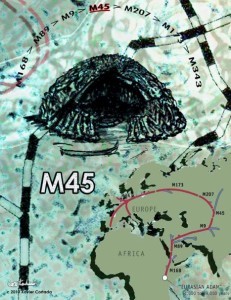Ancestral Journeys (2010)
My work aims to challenge us to find deeper meaning in our present lives by exploring the paths of those who came before us  and our relationship to the natural world.
and our relationship to the natural world.
In 2006, I created Absence of Place, a photo installation at the Miami Art Museum. In it 180 present-day images of absent Miami structures were printed on yellow-card stock and hung in plastic bags. On the wall, beneath each photo I wrote a caption of a memory generated at that site. I did so to give context to the new building at the site — and to give the now absent building life in our collective memory.
Other works have explored our ability to coexist with nature: In 2007, as an Antarctic Artist and Writers program award recipient, I used the moving ice sheet that blankets the South Pole as an instrument to mark time: Juxtaposing Antarctica’s geological time frames (see “The 150,000-year Journey” of a mangrove seedling I planted on the moving ice 1500 Km from the shoreline) with human time frames (see “The Markers,” which uses flags along 500 meters to mark the past 50 years, when humans first inhabited the South Pole), the work reaffirms the notion that we are simply custodians of the planet who should learn to live in harmony with nature.
I am currently focused on creating an evolving body of work that uses genetic data to explore how nature influenced human migration and history. The interdisciplinary work explores the ancestral journeys of this Hemisphere’s current inhabitants. In their blood they capture evidence of the routes their deep ancestors took from their original journey out of Africa 60,000 years ago. By marking the appearance and frequency of genetic markers in modern humans, we can determine when and where ancient humans moved around the world.
As in earlier work, I am engaged in the process of mapping and chronicling to make a point. In this case it has sociological  importance: Perceived differences among people has often allowed for exploitation, marginalization, segregation and alienation. Inside our DNA we carry genetic markers that prove that we share the same ancestors and are one human family.
importance: Perceived differences among people has often allowed for exploitation, marginalization, segregation and alienation. Inside our DNA we carry genetic markers that prove that we share the same ancestors and are one human family.
Today, the biggest threat we face is a lack of connection to one another and to our natural world. We have the capacity to liberate ourselves from this alienation. All humans have the capacity to free their minds of prejudices and practices that are destroying our societies and our planet. Factions, whether based on nationalism, race, class or ethnicity, have created distance between people who are genetically the same. Using DNA from a diverse group of individuals, I am creating work that will challenge the way we see one another and to liberate ourselves from false notions of who we are– or aren’t.
Moreover, by depicting the migrations of our ancestors over the past 60,000 years, we can see how they settled the planet in response to changes in environmental conditions: For our ancestors, the natural world was the only world. They navigated through it —slowly moving where nature provided them with better opportunities to hunt and gather.
Our early ancestors found a way to become a part of natural balance as they populated the planet. Today, we are destroying that balance by overpopulation and by our attempt to use and control nature for our benefit.
 — Xavier Cortada
— Xavier Cortada